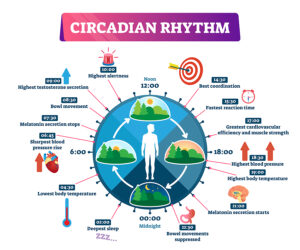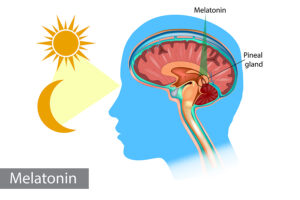A recent review article asked: how healthy are carbohydrates? The three food components that occur in natural food are carbohydrates, fats and protein. Among the carbohydrates it is important to distinguish between simple carbohydrates (such as sugar) and complex carbohydrates. Simple carbohydrates are readily absorbed into the blood, which causes an insulin peak. After a few hours the peak is gone, and there is a “crash”. You will know the feeling of feeling hungry just a few hours after eating doughnuts! Complex carbs like peas, beans, fruit and vegetables take longer to get digested. The final breakdown product of the digestive process is sugar as well. But this process takes longer meaning that the concentration of sugar in the blood is much lower. There is also no “crash”. The result is that complex carbs cause less insulin secretion into the blood.
Long-term effect of eating too much sugar
Integrated over several decades of life, this means that a person who constantly consumes beverages with sugar and snacks containing sugar is at a higher risk of developing type 2 diabetes. In contrast, a person who eats well balanced meals where the insulin secretion is low, will not develop diabetes and have much less hardening of the arteries. This translates into a lower risk to develop heart attacks and strokes.
The types of carbohydrates
Before I discuss the health effects of various carbohydrates, we need to look at the types of carbohydrates.
Simple carbohydrates
Table sugar is a disaccharide, which consists of one molecule of glucose and one molecule of fructose.
The enzyme amylase very quickly breaks down the chemical bond between fructose and glucose and creates these monosaccharides in the small intestine from which they are rapidly absorbed. Milk sugar is a disaccharide, which consists of a molecule of glucose bound to a molecule of galactose. Milk contains 2 to 8% of milk sugar. We have to watch these simple carbs, because they trigger insulin production and lead to accelerated hardening of the arteries, heart attacks and strokes.
Complex carbohydrates
In contrast, complex carbs are healthy, because they take some time to be digested in the digestive tract. They consist of polysaccharides, long chains of sugar molecules. Both starches and dietary fiber consist of complex carbohydrates. They often are present in vegetables and many fruit. Complex carbs slow down the absorption of their breakdown products and minimize the insulin response. Dietary fiber is the indigestible part of fruit and vegetables. It contributes to good gut health as the beneficial gut bacteria can multiply on the fibre particles.
Healthy carbs
When simple carbohydrates dominate in our food intake, we are in trouble because they are loaded with calories. Overconsumption of them leads to weight gain and obesity, to diabetes, heart attacks, strokes and even cancer. On the other hand, consumption of complex carbohydrates is healthy. We get them from eating apples, bananas, berries, vegetables like spinach, tomatoes and carrots. Other healthy complex carbs are whole grain flour, quinoa and brown rice. Black beans, lentils, peas and garbanzo beans are also healthy complex carbs. Dairy products like low fat milk, yogurt and ricotta cheese are healthy as well.
Mediterranean diet as an example of a healthy, balanced diet
In 2019 a study was published where women with polycystic ovary syndrome (PCOS) were either put on a Mediterranean diet or not. This study showed that a Mediterranean diet was anti-inflammatory, reduced insulin resistance and reduced testosterone levels in PCOS patients. But the same is true in a general population. The Mediterranean diet is one example of a healthy, balanced diet with complex carbohydrates. It prevents insulin resistance, inflammation and hormone disbalance. Other diets have similar effects like the DASH diet, the Zone diet and the Pritikin diet.
Quantity and quality of your food intake matters
A 2018 study from India showed that it matters how many carbohydrates we consume. On average Indians eat a diet with 65-75 percent of calories coming from carbohydrates. Many of these carbs are the unhealthy simple carbohydrates. How healthy are carbohydrates? The authors recommended to reduce complex carbohydrates to 50-55% and to add 20-25% protein, mostly from vegetable sources and add 20-30% from fat. The fat consumption needs to include monounsaturated fats (e.g., olive oil, nuts and seeds). Among the carbs a lot of green leafy vegetables help to balance the diet. This prevents the development of type 2 diabetes, heart attacks and strokes.
The above addresses the issue of quality of food. But it is also important what quantity of food we are eating. This is where counting or estimating calories comes in. If we overeat, we will very quickly gain weight and eventually can develop obesity.
The glycemic index and glycemic load
In order to help you with the choice of right carbohydrates the glycemic index was developed.
Here is another reference about the glycemic index/glycemic load.
In table 1 towards the end of the last link you find a column designated “GI” for glycemic index. All the foods that have a value less than 55 are foods that you can eat freely.
Problematical carbohydrate foods
Baked russet potatoes and boiled potatoes are very high on the GI index list. Puffed rice cakes, doughnuts, jelly beans and corn flakes measure high on the glycemic index list. But water melons, dried dates, white bread and white rice are also items to be avoided.
You best avoid anything with a glycemic index above 55. The column to the right of GI shows you a serving size and the last column on the right the glycemic load. The lower the glycemic load per serving, the better it is for your health. The glycemic index and the glycemic load are useful concepts of helping you to sort out your diet items.
My wife and I used this in 2001 to shed weight. We both lost 50 pounds (=22.72 kilograms) each in a period of 3 months.
Fasting mimicking diet (FMD)
According to Dr. Longo intermittent fasting stimulates the stem cells of the bone marrow. This leads to new clones of lymphocytes (B cells and T cells), which are part of the immune system. Your immune system becomes stronger from this.
Dr. Longo has done detailed mouse experiments, which inspired him to develop a new diet plan. Patients would receive a fasting mimicking diet (FMD) on 5 consecutive days per month. The rest of the month consists of a normal, balanced diet. 5 days of the month the person consumes a low 600-800-calorie diet. This reduced calorie intake is enough to ensure adherence to the diet, but low enough to lead to enormous positive metabolic changes including youth-preserving stem cell stimulation.
I am following the FMD
I have followed a FMD since December 2017. It helps me to keep my weight (BMI) in the 21 to 22 range. I feel more energetic and have managed to stay in good health.
The above chapter on the FMD was previously published here.
Conclusion
Healthy eating consists of 50-55% calories from complex carbohydrates; add to this 20-25% protein, mostly from vegetable sources and add 20-30% of total calories from fat. The fat consumption needs to include monounsaturated fats (e.g., olive oil, nuts and seeds). Unfortunately, most “convenience foods” (=processed foods) are incompatible with a healthy lifestyle. They contain too much simple carbs (sugar). Many people live on 65-75 percent of calories coming from simple carbohydrates, which are too many carbs. It should be complex carbs that digest slower and that do not induce insulin resistance. The glycemic index and glycemic load are useful concepts to help you chose the right foods that keep you healthy. The fasting mimicking diet can help you to take the last few pounds off that may be difficult to shed. Weight loss and weight maintenance are possible when you choose the right foods.















